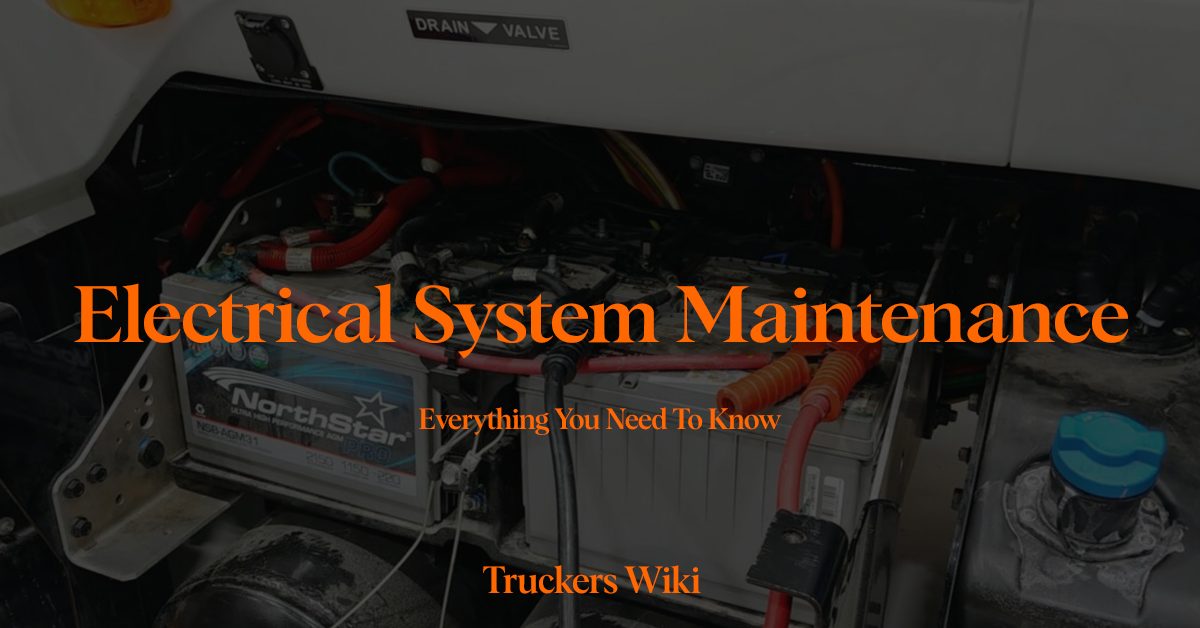
Table of Contents
Semi Truck Electrical System Maintenance
The electrical system is one of the crucial parts of a semi-truck, powering essential components like lights, communication devices, critical engine functions and so much more. Regular electrical system maintenance is essential to ensure seamless truck operations, prevent unexpected breakdowns, and enhance overall safety.
Role of the Electrical System in Truck Operations
The electrical system is responsible for a range of functions, from starting the engine to powering headlights and electronic devices. A well-maintained electrical system ensures proper engine ignition, efficient fuel consumption, and optimal performance of auxiliary equipment.
Learn more about Auxiliary Power Units here.
Overview of Common Electrical System Issues
Truckers should be aware of potential electrical system problems, such as dead batteries, faulty alternators, and wiring issues. These issues can disrupt truck operations and lead to unexpected downtime. Recognizing these problems early and addressing them promptly is crucial for maintaining a reliable electrical system.
Components of the Semi Truck Electrical System
Batteries and Charging System
The batteries store electrical energy used to start the engine and power various systems. The charging system, consisting of the alternator, replenishes the batteries while the engine is running.
Alternator
The alternator generates electrical power and charges the batteries. It’s a crucial component for maintaining a consistent power supply to the truck’s electrical system.
Starter Motor
The starter motor initiates the engine’s ignition process. A healthy starter motor ensures smooth engine cranking.
Wiring and Connectors
Wiring and connectors form the intricate network that delivers electrical power throughout the truck. Ensuring proper connections and insulation is vital for reliable electrical function.
How the Electrical System Works
Battery Power Supply
The batteries provide the initial power needed to start the engine. They also supply electricity when the engine is off, supporting devices like lights and onboard appliances.
Charging and Power Distribution
The alternator generates electricity while the engine is running, replenishing the batteries and powering the electrical system. Excess electricity is stored in the batteries for later use.
Role of the Alternator
The alternator ensures a continuous power supply, even as the truck’s electrical demands vary. It plays a critical role in maintaining battery charge and powering various systems.
Electrical System Maintenance Best Practices
Battery Care and Inspection
Checking Battery Fluid Levels
Regularly inspect battery fluid levels and ensure they are within the recommended range. Low fluid levels can lead to battery damage and reduced performance.
Cleaning Terminals and Connections
Clean battery terminals and connections to prevent corrosion. Corroded terminals can impede electrical flow and affect the battery’s ability to charge and supply power.
Alternator and Charging System Checks
Verifying Charging Voltage
Use a multimeter to measure the voltage output of the alternator. Ensure it falls within the manufacturer’s recommended range for proper charging.
Inspecting Belt Tension
A loose or worn alternator belt can affect the charging system’s efficiency. Check the belt tension and condition, and replace it if necessary.
Starter Motor Health
Listening for Unusual Noises
Pay attention to any unusual clicking or grinding noises during engine startup. Such noises may indicate a failing starter motor.
Ensuring Proper Engagement
A starter motor that struggles to engage may lead to difficulty starting the engine. Promptly address any issues with starter motor engagement.
Wiring and Connector Maintenance
Visual Inspection for Wear or Damage
Regularly inspect wiring and connectors for signs of wear, fraying, or damage. Damaged wiring can cause electrical malfunctions or short circuits.
Ensuring Secure Connections
Ensure all connections are securely fastened. Loose or corroded connections can disrupt the flow of electricity and lead to system failures.
Common Electrical System Issues and Troubleshooting
Dead Batteries
Causes of Battery Drain
Dead batteries can result from leaving lights or accessories on when the engine is off, a malfunctioning alternator, or parasitic draws from faulty components.
Jump-Starting Procedures
Knowing how to jump-start a truck is crucial. Use proper jumper cables and follow correct procedures to safely restart a truck with a dead battery.
Faulty Alternator
Signs of Alternator Failure
Dimming lights, dashboard warning lights, and a discharged battery are indicators of a failing alternator. Prompt attention is needed to prevent complete power loss.
Addressing Charging System Problems
If the alternator is suspected, use a voltmeter to check its output voltage. If the output is inadequate, the alternator may need replacement or repair.
Troubleshooting these common electrical system issues promptly can prevent extended downtime and keep the truck operational.
Now, let’s explore preventive measures to maintain the health of the electrical system.
Regular Battery Checks
Scheduled Voltage Testing
Conduct routine voltage tests on the batteries to ensure they are charging and holding a proper charge. This prevents unexpected battery failures.
Battery Load Testing
Periodically perform load tests to assess the batteries’ ability to deliver adequate power. Replace batteries that fail load tests.
Preventing Corrosion
Using Battery Terminal Protectors
Apply terminal protectors to prevent corrosion on battery terminals. Clean terminals and apply a thin layer of petroleum jelly to deter corrosion.
Applying Anti-Corrosion Spray
Spray an anti-corrosion solution on battery terminals and connectors to create a barrier against moisture and corrosion.
Proper Use of Electrical Accessories
Minimizing Strain on the Electrical System
Avoid overloading the electrical system by using accessories in moderation. Excessive use can drain the batteries and strain the alternator.
Turning Off Accessories When Not in Use
Turn off lights, communication devices, and other accessories when they are not needed. This reduces unnecessary power consumption.
Learn about Pre-Trip Vehicle inspection here.
How To Jumpstart a Semi Truck With a Car video by JFit
Audio Article Electrical System Maintenance Everything you need to know
Last modified: February 24, 2024

